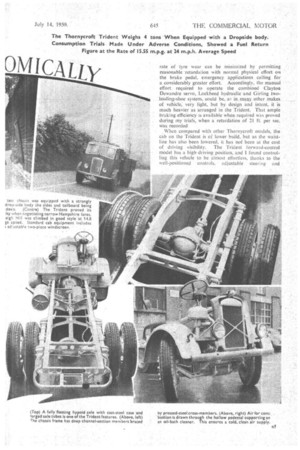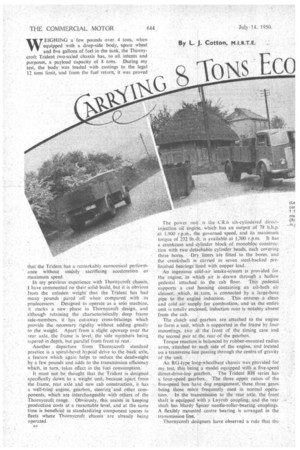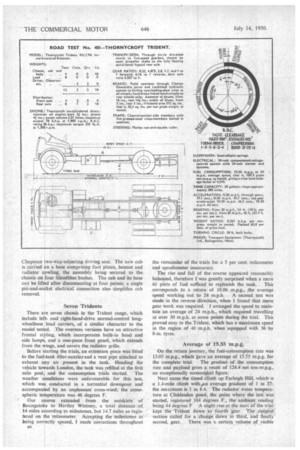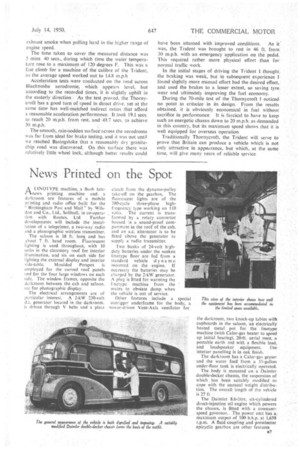OMICALLY
Page 39

Page 38

Page 40

Page 41

If you've noticed an error in this article please click here to report it so we can fix it.
By L. J. Cotton, M.I.R.T.E. WEIGHING a few pounds over. 4 tons, when equipped with a drop-side body, spare wheel and five gallons of fuel in the tank, the Thornycroft Trident two-axled chassis has, to all intents and purposes, a payload capacity of 8 tons. During my test, the body was loaded with castings to the legal 12 tons limit, and from the fuel return, it was proved
that the Trident has a remarkably economical performance without unduly sacrificing acceleration or maximum speed.
In my previous experience with Thornycroft chassis, I have commented on their solid build, but it is obvious from the unladen weight that the Trident has had many pounds pared off when compared. with its predecessors. Designed to operate as a solo machine, it marks a new phase in Thornycroft design, and although retaining the characteristically deep frame side-members, it h,as cut-away cross-bracings which provide the necessary rigidity without adding greatly to the weight. Apart from a slight upsweep over the rear axle, the frame is level, the side members being tapered in depth, but parallel from front to rear.
Another departure from Thornycroft standard practice is a spiral-bevel hypoid drive to the back axle, a feature which again helps to reduce the deadweight by a few pounds and adds to the transmission efficiency which, in turn, takes effect in the fuel consumption.
It must not be thought that the Trident is designed specifically down to a weight unit; because apart from the frame, rear axle and new cab construction, it has a well-tried engine, gearbox, steering-and other, components, which are interchangeable with others of the Thornycroft range. Obviously, this assists in keeping production costs at a reasonable level, and at the same time is beneficial in standardizing component spares in fleets where Thornycroft chassis are already being operated
The power unit is the CR.6 six-cylindered directinjection oil engine, which has an output of 78 b.h.p. at 1,900 r.p.m., the governed speed, and its maximum torque of 232 lb.-ft. is available at 1,300 r.p.m. It has a crankcase and cylinder block of monobloc construe_ tion with two detachable cylinder heads, each covering three bores. Dry liners are fitted to the bores, and the crankshaft is carried in seven steel-backed prefinished bearings lined with copper lead..
An ingenious cold-air intake-system is provided for the engine, in which air is drawn through a hollow pedestal attached to the cab floor. This pedestal supports a cast housing containing an oil-bath air cleaner, which, in turn, is connected by a large-bore pipe to the engine induction. This ensures a clean and cold air supply for combustion, and as the entire unit is totally enclosed, induction roar is notably absent from the cab.
The clutch and gearbox are attached to the engine to form a unit, which is supported in the frame by four mountings, two at the front of the timing case and the second pair at the rear of the gearbox.
Torque reaction is balanced by rubber-mounted radius arms, attached to each side of the engine, and located on a transverse line passing through the centre of gravity of the unit.
An RG-type long-wheelbase chassis was provided for my test, this being a model equipped with a five-speed direct-drive-top gearbox. The Trident RH series has a four-speed gearbox. The three upper ratios of the five-speed box have dog engagement, these three gears being those more frequently used in normal operation. In the transmission to the rear axle, the front shaft is equipped with a Layrub coupling, and the rear shaft has Hardy Spicer needle-roller-bearing couplings. A flexibly mounted centre bearing is arranged in the transmission line. '
Thornycroft designers have observed a rule that the
rate of -tyre wear can be Minimized by permitting reasonable -retardation with normal physical effort on the brake pedal. emergency applications calling for a considerably greater effort. Accordingly, the manual effort required to operate the combined Clayton Dewandre servo, Lockheed hydraulic and Girling two
leading-shoe system, could be,.as man,y other .makes_ of vehicle; very light, but by design and intent, it is . much heavier as arranged in the Trident. That ample braking efficiency is available when required was proved during my trials, when a retardation of 21 ft. per sec. was recorded-.
When compared with other Thornycroft models, the cab on the Trident is of lower build, but as the waistline has also been lowered, it has not' been at the cost of driving visibility. The Trident forward-control model has a high driving position, and I found controlHan this vehicle to be almost effortless, thanks to the well-positioned controls, adjustable steering and : Chapman two-way-adjusting driving seat. The new cab is carried on a base comprising foot plates, bonnet and radiator cowling, the assembly being secured to the chassis on four SiIentbloc bushes. The cab and its base • can be lifted after disconnecting' at four points; a single piri-and-socket electrical connection also simplifies cab removal.
Seven Tridents There are seven chassis in the Trident range, which include leftand right-hand-drive normal-control longwheelbase load carriers, of a similar character to the model tested. The overseas versions have an attractive frontal styling, which incorporates built-in head and side lamps', and a one-piece front panel, which extends from the wings, and covers the radiator grille.
Before starting the trials, an extension piece was fitted to the fuel-tank filler-nozzlqand a vent pipe attached to exhaust any air present in the tank. Heading the vehicle towards London, the tank was refilled at the first mile post, and the consumption trials started. The weather conditions were unfavourable for this test, which was conducted in a torrential downpour and accompanied by an unpleasant cross-wind; the atmospheric temperature was 46 degrees F.
Our course extended from the outskirts of Basingstoke to Hartley Wintney, a total distance -of • 14 miles according to milestones, but 14.7 miles as regis-'21 tered on the mileometer. Accepting the rnilestorieSas being correctly spaced, I made corrections throughout
the remainder of the trials for a 5 per cent. mileometer and speedometer inaccuracy.
The rise and fall of the course appeared reasonably balanced, therefore 1 was greatly surprised when a mere 61 pints of fuel sufficed to replenish the tank. This corresponds to a return of 18.06 rup.g.„the average speed working out to 24 m.p.h. . A second test was made in the reverse direction, when I found that more gear work was required. I arranged the speed to maintain an average of 24 m.p.h., which required travelling at over 30 m.p.h. at some points during the trial. This proved easy to the Trident, which has a maximum speed in the region of 40 m.p.h. when equipped with 36 by 8-in.. tyres.
Average of 15.55 m.p.g.
On the return journey, the fuel-consumption rate was 13.05 m.p.g., which gave an average of 15.55 m.ps. for the complete trial. The product of the consumption rate and payload gives a result of 124.4 net ton-mpg., an exceptionally economical figure.
Next came the timed climb up Farleigh Hill, which is a 1.4-mile climb with van average gradient of.! in 27; the maximum is 1 in 8.4. The radiator water temperature at Cliddesden pond, the point where the test was started, registered104 degrees F., the ambient reading being 44 degrees F A sitght rise at the start of the trial kept the Trident down to fourth gear. The steepest , section called for a change down' to third, and ana.11y second, gear. There was a certain volume of visible
July 14, 1950. 647 ' exhaust smoke when pulling hard in the higher range of engine speed.
The time taken to cover the measured distance was 5 mins 40 secs., during which time the water temperature rose to a maximum of 120 degrees F. This was a fast climb for a machine of the calibre of the Trident, tis the average speed worked out to 14.8 in.p.h
Acceleration tests were conducted on the road across Blacknushe aerodrome, which appears level, but according to the recoicred times, it is slightly uphill in the easterly direction As the test proved. the Thornycroft has a good turn of speed in direct drive, yet at the same time has well-matched indirect ratios that afford a reasonable acceleration performance: It took 19.1 secs. to reach 20 m.p.h. from rest. and49.7 secs. to achieve 30 m.p.h.
The smooth, rainsodden s-urface'across the aerodrome was far from ideal for brake testing, and it was not until we reached Basingstoke that a reasonably dry granitechip road was discovered. On this surface there was relatively little wheel lock, although better results could
have been attained with improved conditions. As it was, the Trident was brought to rest in 46 ft. from 30 m.p.h. with an emergency application on the pedal. This required rather more physical effort than for normal traffic work.
In the initial stages of driving the Trident I thought. the braking was weak, but in subsequent experience found slightly more manual effort had the desired effect, and used the brakes to a lesser extent, so saving tyre. wear and ultimately improving the fuel economy.
During the 70-mile test of the Thornycroft I noticed no point to criticize in its design. From the results obtained, it is obviously economical in fuel without sacrifice in performance It is farcical to have to keep such an energetic chassis down to 20 m.p.h. as demanded in this country, but its maximum speed shows that it is well equipped for overseas operation
Traditionally Thornycroft, the Trident will serve to prove that Britain can produce a vehicle which is not only attractive in appearance, but which, at the same time, will give many years of reliable service












































































